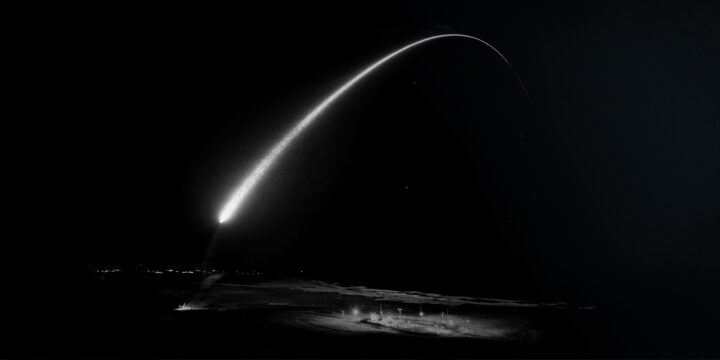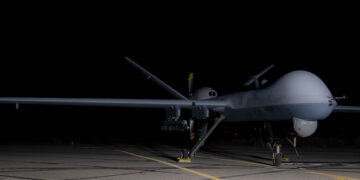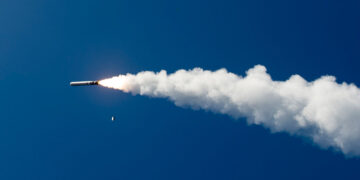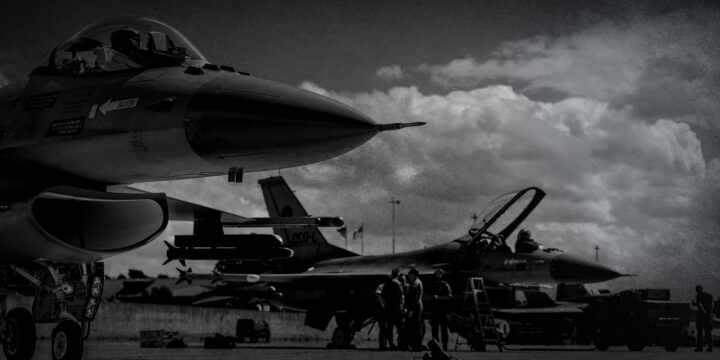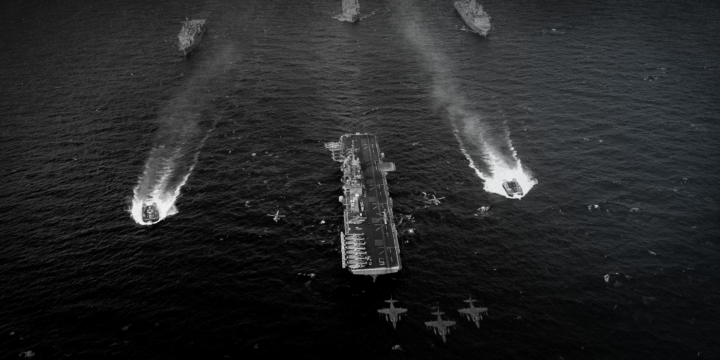July 8, 2024
A new NATO agenda: Less U.S., less dependency

Key points
- The United States should aggressively reduce its force presence in Europe.
- This would be consistent with NATO’s original balancing purpose and U.S. expectations then that garrisoning Europe was a temporary expedient, not a permanent tool of U.S. dominance.
- The Russian threat, despite being energized by NATO expansion, is insufficient to demand the current defense effort devoted to it in Europe, whether it’s Americans or Europeans making that effort.
- The results of Russia’s invasion of Ukraine underline this happy point: Russia has proven weaker than conventional wisdom held, and the advantages of defense evident in the war bode well for the territorial status quo NATO defends in Europe.
- A U.S. drawdown in Europe is unlikely to spark a European defense renaissance, but even so, the balance of power in Europe will remain intact, and the United States will be better off with the freed-up resources and reduced risks.
The U.S. should reform its approach to NATO
At 75, the North Atlantic Treaty Organization (NATO) seems to be in robust health. Despite decades of warnings that NATO must evolve or reform, the alliance soldiers on, exalted by transatlantic leaders regardless of its capability.1The classic example is Sen. Richard Lugar’s statement that NATO had to either “go out of area or go out of business.” Richard Lugar, “NATO: Out of Area or Out of Business. A Call for U.S. Leadership to Revive and Redefine the Alliance,” Remarks Delivered to the Open Forum of the U.S. State Department, August 2, 1993. Rather than fade away, it has serially expanded. Even the Trump administration, rhetorically the most hostile to NATO since its inception, did nothing concrete to undermine the alliance’s foundation: U.S. force structure in Europe, the defense spending funding it, and the nuclear threats that remain the essence of U.S. extended deterrence there.2Benjamin H. Friedman and Joshua Shifrinson, “Trump, NATO, and Establishment Hysteria,” War on the Rocks, June 16, 2017, https://warontherocks.com/2017/06/trump-nato-and-establishment-hysteria/.The Russian invasion of Ukraine in 2022 invigorated the alliance, drawing pledges of new spending, expansion to Sweden and Finland, and newfound heights of rhetorical support, especially in Washington.3“Statement from President Joe Biden on NATO’s 75th Anniversary,” The White House, April 4, 2014, https://www.whitehouse.gov/briefing-room/statements-releases/2024/04/04/statement-from-president-joe-biden-on-natos-75th-anniversary/.
But NATO’s political success does not make it a good deal for Americans. The United States should reduce its commitment to Europe’s defense, and hence to NATO, for the simple reason that U.S. security no longer requires anything like the present U.S. effort there. The limits of the Russian threat, recently laid bare in Ukraine, mean the U.S. objective in Europe of maintaining a stable balance of power—and thus preventing Russian hegemony—can be achieved at a much cheaper price.4William T. R. Fox. “American Foreign Policy and the Western European Rimland.” Proceedings of the Academy of Political Science 22, no. 4 (1948): 71–78. https://doi.org/10.2307/1172872. A drawdown of U.S. forces will not imperil Europe’s stability, whether or not increased European defense efforts totally replace current American deployments. Certainly, a more militarily capable Europe, one less dependent on U.S. support, would be a nice, but not necessary, side effect of any U.S. drawdown. But waiting for allies to step up before exiting is a recipe for endless waiting.5Justin Logan, “Uncle Sucker: Why U.S. Efforts at Defense Burdensharing Fail,” Cato Institute, Policy Analysis no. 940 (Washington, DC, March 7, 2023), https://www.cato.org/sites/cato.org/files/2023-03/policeyanalysis-940.pdf.
Via NATO, the United States has entrapped itself in a transatlantic catch-22: U.S. leaders want allies to step up to reduce U.S. defense burdens, but they like keeping allies as dependents, not as independent and potentially contrary forces in world politics. So they keep providing defenses that largely shield Europeans from decisions about whether to really do more, individually or through collective means. The United States blocks the European balancing efforts it ostensibly desires before it can reduce U.S. burdens.
Europeans have a good deal. U.S. benevolence prevents them from having to think about seriously reallocating resources to meet the Russian threat. In exchange, they endure patronizing lectures from Americans about their defense efforts. Arguably they do lose something: the opportunity to forge a meaningful foreign policy backed by force as Europe, or what we now call strategic autonomy. But even if U.S. forces got out of the way, whether the Russian threat would undergo a major shift is unclear.
So NATO hardly needs to reform at 75. Having successfully entrapped the world’s greatest military in an arrangement that subordinates U.S. interests in perpetuity, NATO is healthier than it deserves to be. It is the United States that should reform its approach to NATO. The policy shift in order is straightforward: initiating a gradual removal U.S. forces from Europe, even as a political commitment to NATO remains, backed by the threat of nuclear devastation of Russia.
Winning support for this move is where the bigger challenge lies. That requires reviving NATO’s original balancing purpose and acknowledging it can be achieved absent heavy U.S. effort. Rather than arguing for a shift in burdens to allow for reductions in the United States’ effort and dwelling on Europe’s free ride, skeptics of U.S. policy in Europe should focus on the limits of the Russian threat and wisdom of U.S. burden dropping, regardless of whether it’s taken up.
Pursue balancing, not burden sharing
U.S. defense policy in Europe is badly off course, and we are having the wrong debate about why. One perspective, dominant among the foreign policy establishment, nominally seeks to better share the burden of Europe’s defense with European allies, but basically endorses the policy status quo, seeing a dominant U.S. role in Europe as an important means to exercise global influence. It supports greater spending by European states but views suspiciously any joint European efforts outside NATO, insisting they not go too far lest they interfere with NATO and U.S. influence.6See, for example, then-secretary of state’s Madeline Albright’s “3Ds” initiative insisting that any European Union defense initiatives avoid decoupling of European defense structures from NATO, duplicating NATO capability, and discriminating against NATO members not in the European Union. Maartje Rutten ed. “Madeleine K. Albright, U.S. Secretary of State ‘The Right Balance Will Secure NATO’s Future,’ Financial Times, December 7, 1998.” FROM ST-MALO TO NICE: European Defence: Core Documents. European Union Institute for Security Studies (EUISS), 2001, http://www.jstor.org/stable/resrep06989.8. This idea of burden sharing is narrowly circumscribed: it is designed to get better sidekicks, not real partners.7The Pentagon has long published a report on allied burden sharing to shame allies into spending more. See, e.g., U.S. General Accounting Office Report to the Chairman, Committee on Armed Services, House of Representatives, “U.S.-NATO Burden Sharing: Allies’ Contributions to Common Defense During the 1980s,” https://www.gao.gov/assets/nsiad-91-32.pdf. For a list of U.S. leaders insisting on higher European defense spending going back to the Kennedy administration, see Friedman and Shrifrinson, “Trump, NATO, And Establishment Hysteria.”
Another view, from those more skeptical of the status quo, supports greater burden sharing.8On the success of burden sharing as a policy, see Brian D. Blankenship, The Burden-Sharing Dilemma: Coercive Diplomacy in U.S. Alliance Politics (Ithaca, NY: Cornell University Press, 2023), http://www.jstor.org/stable/10.7591/jj.130890. It is willing to accept independent European military capability as a mean to reduce U.S. burdens.9A recent example is Rachel Rizzo and Michael Benhamou, “Europeanize NATO to Save It,” Defense News, June 11, 2024, https://www.defenseone.com/ideas/2024/06/europeanize-nato-save-it/397299/. But it implicitly shares the establishment’s assumption that Russia’s threat to Europe requires that NATO collectively maintain at least its current capability. It argues that any reduction in U.S. effort must be matched by an equivalent or greater increase in other alliance members’ contributions. Europe does more, so the United States can do less, the thinking goes.
A third and better approach to defending Europe focuses on the balance of power in Europe and how preserving it now requires far less from the United States. This approach is consistent with how U.S. leaders viewed NATO at its inception. The goal back then was not to dominate Europe, govern the international order, or spread democracy. It was to temporally buttress European states’ defense, especially West Germany’s, lest their collapse—either under conquest or subversion—threaten the United States.10Marc Trachtenberg, A Constructed Peace: The Making of the European Settlement, 1945–1963 (Princeton, NJ: Princeton University Press, 1999). How exactly that threat would manifest on U.S. shores was less clear, given U.S. distance from Europe, military power, and nuclear weapons. The usual answer was that Soviet dominance of Europe would mean using its industry to grow communist militaries, closing off U.S. trade and forcing the U.S. into a defensive crouch as an illiberal and impoverished garrison state.11Aaron Friedberg, In the Shadow of the Garrison State: America’s Anti-Statism and Its Cold War Grand Strategy (Princeton, NJ: Princeton University Press, 2000).
Early in the Cold War, the Soviet Union, at least on paper, had 175 active army divisions (their Warsaw Pact allies another 75), with 26 of them forward deployed in Eastern Europe and at least 2.5 million men in the army plus large reserves of forces upon which to draw.12Richard Bitzinger, Assessing the Conventional Balance in Europe, 1945-1975 (RAND Corporation, 1989), https://www.rand.org/pubs/notes/N2859.html, 5. The militaries of NATO, when it was formed, had maybe 20 army divisions, far fewer men under arms, far smaller reserves, and only a handful of divisions ready to fight in Europe.13Bitzinger, 5–6. In retrospect, we know conventional takes on the Soviet threat were overstated, with little of that power ready to fight and the Soviets themselves deeply reluctant to fight another world war to conquer Western Europe.14On the overstatement of Soviet capability at the start of the Cold War, see Matthew Evangelista, “Stalin’s Postwar Army Reappraised,” International Security 7, no. 3 (Winter 1982–1983). On the lack of Soviet plans for aggression, see, e.g. John Mueller, Atomic Obsession: Nuclear Alarmism from Hiroshima to Al-Qaeda (London: Ohio University Press, 2012), p. 36; John Lewis Gaddis, We Now Know: Rethinking Cold War History (New York: Oxford University Press, 2007) p. 31; and Nicolai Petro and Alvin Rubinstein, Russian Foreign Policy: From Empire to Nation-State (New York: Addison-Wesley, 1997), 65–67. But in any case, Washington perceived a severe imbalance and sought to swiftly fix it by sending troops to Europe and building up allied capability with aid.
The U.S. effort to preserve the European balance of power at the start of the Cold War was not meant to be a permanent one. Different leaders had different agendas, of course, but American strategy was expressly designed to get U.S. forces home once the perceived emergency passed.15Brendan Rittenhouse Green, “Two Concepts of Liberty: U.S. Cold War Grand Strategies and the Liberal Tradition,” International Security 37, no. 2 (Fall 2012): 9–43. The crux of that policy was to rebuild Germany within Western Europe, so that allied states could stand against the Soviet Union.16Trachtenberg, A Constructed Peace, chapter 4. To the same end, the Eisenhower administration even supported the development of a European Army within the European Defense Community—outside NATO.17Louis Galambos, Eisenhower: Becoming the Leader of the Free World (Baltimore: Johns Hopkins University Press, 2020), 163. In 1951, President Eisenhower stated that the purpose of NATO was to help Western European countries “regain their confidence and get on their own military feet” and warned that “if in 10 years, all American troops stationed in Europe for defense purposes have not been returned to the United States, then this whole project will have failed.”18Quoted in Trachtenberg, A Constructed Peace, 147, 148.
By the mid-Cold War, NATO had not only addressed the imbalance of power favoring the Soviet Union, it had also reversed it, at least when one weighed economic potential to produce forces and force quality along with raw force structure numbers.19Barry R. Posen, “Measuring the European Conventional Balance: Coping with Complexity in Threat Assessment,” International Security 9, no. 3 (Winter 1984): 47–88, https://doi.org/10.2307/2538587. Had the United States maintained the balancing policy it had at the start of the Cold War, it would have begun pulling forces from Europe well before the Cold War ended. But by then, Washington had broadly changed its views on the point of NATO.
The causes of this shift are not fully explored in this paper, but they involved a broad adoption among the U.S. elite of what we now call the grand strategy of primacy, which includes the idea that alliances are not expedients to win wars or balance power but foundational sources of U.S. global military hegemony.20Given the difficulties of selling the public on the need to suppress even allies’ capabilities and sensibilities, this rationale is rarely fully stated by U.S. officials. An exception was the 1992 Defense Policy Guidance. Patrick E. Tyler “U.S. Strategy Plan Calls for Insuring No Rivals Develop,” New York Times, March 8, 1992, https://www.nytimes.com/1992/03/08/world/us-strategy-plan-calls-for-insuring-no-rivals-develop.html. Benjamin H. Friedman and Harvey M. Sapolsky, “Unrestrained: the Politics of America’s Primacist Foreign Policy,” in Benjamin H. Friedman and Trevor Thrall eds., U.S. Grand Strategy in the 21st Century: the Case for Restraint (London: Routledge, 2018), 220–242. In this view, even partial U.S. departure from NATO would imperil global order.
So even when the Cold War ended, and the threat justifying the U.S. presence in NATO collapsed, the U.S. drawdown from Europe was partial—about 200,000 military personnel removed, but about 100,000 remaining to preserve a dominant U.S. role in Europe.21U.S. Government Accountability Office, “Force Structure: Basis for Future Army Forces in Europe,” NSIAD-94-43 (Washington, DC, 1994), https://www.gao.gov/assets/nsiad-94-43.pdf. Although the number of U.S. forces dropped even lower in recent years, it returned to around 100,000 after the Russian invasion of Ukraine.22Leo Shane III, “U.S. Troop Numbers in Eastern Europe Could Continue to Grow,” Defense News, April 10, 2024, https://www.defensenews.com/news/pentagon-congress/2024/04/10/us-troop-numbers-in-eastern-europe-could-continue-to-grow/.
Doing less in Europe would enhance U.S. security
Keeping a large contingent of forces in Europe after the Cold War was a historic mistake, and even more so was the hegemonic purpose they serve. This policy has misallocated U.S. resources and served more to stoke the Russian threat than to contain it. That is more a problem for Eastern Europeans, especially Ukrainians, than Americans, but the net result for Americans has been reduced security.
The U.S. commitment to NATO is cheap, according to the normal way the U.S. government accounts for it, which essentially includes only the incremental cost of stationing troops overseas versus keeping them stateside.23The Pentagon claims it spends only $30 billion or so overseas worldwide because it counts these costs in the narrowest way. Office of the Under Secretary of Defense (Comptroller)/Chief Financial Officer, “Defense Operation & Maintenance Overview Book,” (May 2023), 324. On how DoD produces such figures, and other more inclusive counting methods, see Stephen Daggett, “Defense Budget: Alternative Measures of Costs of Military Commitments Abroad,” Congressional Research Service, June 16, 1995. But the real cost is far higher. An alliance is a commitment to fight a war, and such commitments drive the defense budget—the force structure it requires, the administrative costs behind that, and much else. If the United States did not plan to defend Europe, or planned to do so only as a support force, it could buy and spend far less to equip, train, and administer the forces it has there plus some at home. It could also trim its nuclear arsenal. How much savings all that would produce is nearly impossible to say, not just because of Pentagon accounting, but also due to many judgments necessary to make those cuts. But even $50 billion a year is a conservative guess.24One recent estimate suggests the cost of the U.S. missions in the Middle East, where the United States, including rotational deployments by air and naval forces, has around two-thirds of the forces it has in Europe, at $65-70 billion a year. Eugene Gholz, “U.S. Spending on Its Military Commitments to the Persian Gulf,” in Charles L. Glaser and Rosemary A. Kelanic, eds., Crude Strategy: Rethinking the U.S. Military Commitment to Defend Persian Gulf Oil (Washington, DC: Georgetown University Press, 2016), 167–195. That is a drop in the bucket of federal spending, but it is a substantial lost opportunity to invest against other threats, like China, and in other programs more likely to enhance Americans’ welfare—or just to keep more in taxpayers’ pockets.
For this investment, Americans get worse than nothing. The U.S. presence in Europe helped give the alliance the confidence to serially expand into the former Warsaw Pact and to Russia’s doorstep.25Joshua R. Itzkowitz Shifrinson. ”Deal or No Deal? The End of the Cold War and the U.S. Offer to Limit NATO Expansion,” International Security 40, no. 4. (Spring 2016): 7–44. This policy had the unintended effect of preserving and enhancing Russian enmity, as skeptics predicted it would.26John J. Mearsheimer, “Why the Ukraine Crisis Is the West’s Fault: The Liberal Delusions That Provoked Putin,” Foreign Affairs 93, no. 5 (September/ October 2014): 77–89. The very long odds of nuclear war got a bit shorter.
Expansion also gave NATO, which principally means the United States, some intractable defensibility problems to confront, especially in the Baltics and now Finland, which has an 800-mile land border with Russia. On top of all that, since NATO functions on consensus, expansion made the problem of aligning all the members far more difficult. While NATO expansion had some beneficiaries—new members sure like being under U.S. nuclear protection—for the United States, it brought bigger problems.
Ukraine shows the limits of the Russian threat
Washington’s policy reaction to Russia’s invasion of Ukraine in 2022 was to up its efforts in Europe and redouble its commitment to NATO. In short order, the United States had deployed an extra 20,000 forces mostly to Eastern Europe, on top of the 80,000 already nearby. Most NATO states had a similar reaction, and 20 European states, most prominently Germany, quickly pledged to increase defense spending.27Esme Kirk-Wade and Sanjana Balakrishnan, “Defence Spending Pledges by NATO Members since Russia Invaded Ukraine,” Insight, House of Commons Library, August 11, 2022, https://commonslibrary.parliament.uk/defence-spending-pledges-by-nato-members-since-russia-invaded-ukraine/.
There were two problems with this response. One was that Russia’s targeting of Ukraine did not demonstrate intent to attack elsewhere. Even those who ignore the substantial evidence that the prospect of NATO membership for Ukraine—or simply of NATO forces there—helped provoke Russia’s aggression should acknowledge that Russia had special concerns about Ukraine and the choices of its government, which placed it in a kind of danger not present elsewhere, even in Georgia, let alone NATO members.28Christopher McCallion, “Assessing Realist and Liberal Explanations for the Russo-Ukrainian War,” Defense Priorities, June 7, 2023, https://www.defensepriorities.org/explainers/assessing-realist-and-liberal-explanations-for-the-russo-ukrainian-war. Russia’s threat to its closest neighbors just does not tell us much about its threat to the heart of NATO. The idea that Ukraine was the opening step in a bid to recreate the Soviet Union, let alone to attack Western European states, lacks evidence.
The bigger problem with the idea the Ukraine war requires newfound exertions in NATO is how the war showed Russia’s weakness. Once Russian forces bogged down outside Kyiv, failed to land in Odesa, and had to retreat to the Donbas, their threat seemed less dire than when all those defense pledges had been made. Russian forces displayed an inability to execute combined arms warfare, terrible morale, and logistical deficiencies.29 Kirill Shamiev, “Brass Tacks: Why Russia’s Military Fails to Reform,” European Council on Foreign Relations, May 15, 2024, https://ecfr.eu/publication/brass-tacks-why-russias-military-fails-to-reform/. They have suffered upwards of 300,000 casualties and lost vast stores of vehicles.30Brad Dress, “U.S. Says Russia Has Suffered 315K Casualties in Ukraine,” Hill, February 16, 2024, https://thehill.com/policy/defense/4472378-russia-315k-casualties-ukraine-us/. True, Russia has partially overcome these problems, filling in its ranks and rebuilding equipment at an impressive rate, which helped them stabilize the lines and then make some halting progress.31Noah Robertson, “‘They’ve Grown Back’: How Russia Surprised the West and Rebuilt its Force,” Defense News, May 21, 2024, https://www.defensenews.com/global/europe/2024/05/21/theyve-grown-back-how-russia-surprised-the-west-and-rebuilt-its-force/. But their capability to go on offense has not demonstrably improved, and the problems of morale and logistics seem likely to return should they try another invasion, especially of a NATO state. Russian forces remain largely stuck east of the Dnipro River, a far cry from an army likely to come sweeping toward Poland.
Beyond the failures peculiar to Russia, their aggression has been a demonstration of why states increasingly avoid invading other countries.32On the decline of interstate war and attempts at conquest, see Steven Pinker, The Better Angels of Our Nature: Why Violence Has Declined (New York: Viking Books, 2011), chapter 5. Defense has political advantages, as Clausewitz long ago noted, and newfound technological ones, which operate at a more tactical level of warfare.33Carl von Clausewitz, On War, edited and translated by Michael Howard and Peter Paret (Princeton NJ: Princeton University Press, 1984), 357–393. See also, Barry R. Posen, The Sources of Military Doctrine, France, Britain, and Germany Between the World Wars (Ithaca, NY: Cornell University Press, 1984), 47–51. When countries are attacked, which is usually the case for defenders, they tend to develop a stronger sense of nationalism. Russia’s assaults on Ukraine ironically built up the nation whose national identity they sought to suppress or destroy. Because defenders are typically fighting for their own territory, they usually have higher morale than attackers. Defenders, because they are likely to be victims of aggression, also tend to attract outside support. Russia aggression elicited a furious outpouring of Western support, which has been vital to Ukraine’s cause.
The technical advantages defenders have in Ukraine—evident on both sides as opposing forces mount offensives—have resulted from the marriage of improved surveillance and targeting.34David Johnson, “Ending The Ideology Of The Offense, Part II,” War on the Rocks, August 25, 2022, https://warontherocks.com/2022/08/ending-the-ideology-of-the-offense-part-ii/; Frank Hoffman, “American Defense Priorities After Ukraine,” War on the Rocks, January 2, 2023, https://warontherocks.com/2023/01/american-defense-priorities-after-ukraine/. Various surveillance systems, with drones now playing a leading role, allow defending forces to see enemy forces attempting advances with newfound clarity. This information can be translated quickly into targeting information for various fires. The proliferation of portable and accurate anti-tank weapons adds to this effect. In addition, advanced air defense systems and man-portable air-defense systems make it difficult for aircraft to offer advancing forces close air support, or do much else.35Justin Bronk, Nick Reynolds, and Jack Watling, “The Russian Air War and Ukrainian Requirements for Air Defence,” RUSI, November 7, 2022, https://static.rusi.org/SR-Russian-Air-War-Ukraine-web-final.pdf. Massing forces to achieve breakthroughs across defensive lines has become prohibitively costly.
To what extent these defensive advantages would prevail against more capable militaries like the United States’ is an interesting, but for present purposes academic, question. There is no state threat to European stability beyond Russia, and Russia’s troubles would only intensify in a fight against NATO. This is great news for the territorial status quo in Europe. The United States should take advantage of that by intensifying efforts to let allies take up the burden of their own defense.
Let Europe do what it wants on defense
The United States should immediately begin drawing down the forces it has in Europe, starting with the 20,000 added since the war in Ukraine began, who are mostly in Eastern Europe. This can proceed at a slow pace, over years, to help allies adjust. It need not entail a renunciation of the NATO treaty. That commitment can be honored by planning to provide long-range support for allies, via airpower if needed, and using U.S.-based ground forces as an emergency reserve for Europe, rather than its front-line troops.
This suggestion does not come from ill will against Europeans. To the extent that Europeans, even as they got rich, benefitted from a free ride on U.S. taxpayers’ dimes and U.S. servicemembers’ protection, the fault lies in Washington. The allies sensibly took the gifts on offer. Nor should the removal of U.S. forces be taken as an exit from the continent, or even disinterest in Europe’s political fortunes. It should come rather from sober recognition that the U.S. military stayed too long, and no threat justifies their continued presence at current numbers. Neither should advocating for a drawdown be taken as disinterest in Ukraine or forgiveness of Russia’s actions there. NATO and aid to Ukraine, a non-NATO member, are separate matters. Ceasing to base U.S. policy on an exaggeration of Russia’s threat beyond Ukraine and forgiving its aggression likewise are not the same thing.
The United States should not begin withdrawing troops in the expectation that European forces rise in their wake. This could occur, but as noted, the weakness of Russia means both that it might not and that the United States will be safe regardless. Decoupling U.S. defense policy from European efforts might even improve trans-Atlantic relations in some respects. It would reduce Americans’ resentment and tendency to patronize Europeans by explaining their security interests to them.
When people talk about burden-shifting and increasing European defense efforts, they can mean one of several things. The more prominent and cruder meaning is spending, often expressed as a percentage of gross domestic product. NATO members’ pledge to spend 2 percent of their GDPs on defense is the big example. Unfortunately, this is a bad measure to use alone, given that GDP fluctuations could obscure actual defense investments. Economic growth may give the false appearance of disinterest in defense; likewise recessions may give the false appearance of increased military spending. What’s more, this measure tends to distract people from what value military spending is producing—that is from capability. So when NATO’s secretary general, using generous rounding, claims 23 of 32 NATO states now meet the 2 percent threshold, we are meant to cheer and lose sight of what that means for the alliance’s collective capability to fight.36Stuart Lau, June 18, 2024, “Record 23 Countries Hit 2 percent Defense Spending Target, NATO Says,” Politico Europe, https://www.politico.eu/article/defense-spending-target-nato-joe-biden-jens-stoltenberg/.
Another way to assess Europe’s defense efforts is by capabilities, which are harder to measure but more important.37An example is the U.S. Initiative “30-30-30-30,” where NATO would have 30 land battalions, 30 fighter squadrons, and 30 ships ready to deploy within 30 days. Robin Emmott and Idrees Ali, “U.S. Pushes NATO to Ready more Forces to Deter Russian Threat,” Reuters, June 5, 2018, https://www.reuters.com/article/idUSKCN1J11NO/. This effort seems to have vanished, or it was subsumed by a post-Ukraine invasion NATO plan to go from 40,000 to 300,000 “high readiness” forces. Lili Bayer, “NATO Will Increase High-readiness Force to ‘Well Over’ 300,000 Troops,” Politico Europe, June 27, 2022, https://www.politico.eu/article/nato-increase-high-readiness-force-300000/. For more recent, dubious claims by NATO officials to have achieved this aim, see Stuart Lau, “NATO Exceeds 300,000 Force Target amid Russian Threat,” Politico Pro, June 13, 2024. Capability can be achieved by cross-national or EU initiatives such that you are getting increased European capability not reliant on NATO—strategic autonomy.
Realism says states seeking security balance power, either by allying or their own internal methods.38The classic work on balancing is Kenneth Waltz, Theory of International Politics (Reading, MA: Addison-Wesley, 1979). On alliance formation see Stephen M. Walt, The Origins of Alliances (Ithaca, NY: Cornell University Press, 1987). So increased threats, like what Russia invading Ukraine seems to reveal, should increase balancing, with the caveat that threat perception varies with geography and tends to be oddly subjective.39On differing perceptions of the balance of power in the Cold War, see William Curti Wohlforth, The Elusive Balance: Power and Perceptions During the Cold War (Ithaca, NY: Cornell University Press, 1993). But reactions in Europe are complicated by the role of the world’s most powerful country as the continent’s protector. Why balance Russian power if the United States will do it for you?
European defense spending can then be thought of as a combination of two significant factors: (1) how big the threat of Russia is and (2) the extent to which U.S. protection discourages local balancing. Since the 2022 invasion, U.S. policy, while in theory in favor of greater European efforts, in practice suppresses those efforts. By sending more forces to Europe, providing the bulk of the military support for Ukraine, and repeatedly claiming U.S. security depends on the security of its NATO allies, Washington effectively told Europeans, who had just pledged to do more, not to worry about it.
European defense spending nonetheless increased markedly from 2022 to 2023, which is testament to the initial shock of the Russian invasion.40According to SIPRI, European military spending increased 16 percent from 2022 to 2023, including Russia. Spending in Western and Central Europe reportedly increased 10 percent. Nan Tian, Diego Lopes Da Silva, Xiao Liang, and Lorenzo Scarazzato, “Trends In World Military Expenditure, 2023,” SIPRI Fact Sheet (April 2024), https://www.sipri.org/sites/default/files/2024-04/2404_fs_milex_2023.pdf. Given U.S. policy, the static course of the war, and the pace of budget making, one should expect that increase to smooth out or end in the next few years. German Chancellor Olaf Scholz’s “Zeitenwende” plan to spend an extra €100 billion (about $112 billion at the time) on defense will be the key test. The plan is underway, with the extra funds reportedly to be spent through 2028, and Germany now says it is spending 2 percent of its GDP on defense with the addition of those temporary funds.41Molly O’Neal, “What’s Holding Back German Rearmament? It Turns Out, A Lot,” Responsible Statecraft, May 13, 2024, https://responsiblestatecraft.org/german-military-nato/. But it is unclear if Germany will sustain this commitment, given coming elections, coalition politics, and potentially reduced fears of Russia’s menace.42Sabine Siebold and Maria Martinez, “Infighting Over Budget Imperils Germany’s Defence Upgrade,” Reuters, June 11, 2024, https://www.reuters.com/world/europe/infighting-over-budget-imperils-germanys-defence-upgrade-2024-06-11/. Another question is whether the added funds, even if they fully materialize, will fill key gaps in European capabilities, like transport, firepower, and manpower, rather than going to less useful high-end systems, like F-35s.43Jennifer Kavanaugh, “Retire the 2 Percent of GDP Military Spending Target,” Defense Priorities Symposium: Antique Alliance: Rethinking NATO at 75, July 2, 2024, https://www.defensepriorities.org/symposia/antique-alliance-rethinking-nato-at-75/#jennifer-kavanagh.
The war in Ukraine does not seem to have done much for strategic autonomy. While there are new calls to bulk up the European Union’s defense buying capabilities, they have not yet produced much increase.44Bjarke Smith-Meyer, “France Pitches Radical Joint EU Borrowing Plan to Pay for Defense,” Politico Europe, March 20, 2024, https://www.politico.eu/article/france-pitch-radical-joint-eu-borrowing-plan-pay-defense/; Jacopo Barigazzi, Laura Kayali, and Joshua Posaner, “EU Plans To Create Defense-Industrial Complex Ready for War,” Politico Europe, https://www.politico.eu/article/eu-plan-war-ready-complex-european-defence-industrial-strategy/; Aurélie Pugnet, “EU Commission Tables Ambitious Defence Single Market Programme, But with Modest Funds,” Euractiv, March 5 2024, https://www.euractiv.com/section/defence-and-security/news/eu-commission-tables-ambitious-defence-single-market-programme-but-with-modest-funds/. Nor has Permanent Structured Cooperation, an EU program to encourage collaborative defense procurement, markedly increased its projects in the last two years.45Stefania Rutigliano, “Ukraine Conflict’s Impact on European Defence and Permanent Structured Cooperation (PESCO),” European Papers, November 21, 2023, https://www.europeanpapers.eu/en/europeanforum/ukraine-conflicts-impact-european-defence-and-p.ermanent-structured-cooperation-pesco. Overall, Europe remains on roughly the same winding path toward common foreign and security policy that it began long before the war.46Barry R. Posen, “European Union Security and Defense Policy: Response to Unipolarity?,” Security Studies 15, no. 2 (2006): 149–186. There appears to be little urgency, whatever the twin terrors of Vladimir Putin and Donald Trump, to escape dependency on the United States.
A U.S. drawdown in Europe would surely boost both overall defense spending there and efforts to increase strategic autonomy. But given the mammoth distance between the current reality and something like a European army, skepticism about the transformational effects of a U.S. withdrawal is warranted. That might take a major increase in Russia’s threat to boot. That could mean a sudden collapse in Ukrainian lines, long-term Russian militarization, or both. It could take the nightmare scenario envisioned by most self-proclaimed transatlanticists, where the U.S. leaves as Russia rises, to finally produce energetic European-led balancing.
With a durable balance of power, Americans have the luxury to worry less about what Europeans do to defend themselves. They have plenty of untapped capability to do more if the need becomes more acute.47Barry R. Posen, “Europe Can Defend Itself,” Survival 62, no. 6 (2020): 7–34. A European transition to a NATO where the United States is not militarily dominant would not be seamless.48On what Europe might do to make this transition, see Mike Sweeney, “How Would Europe Defend Itself?,” Defense Priorities, April 11, 2023, https://www.defensepriorities.org/explainers/how-would-europe-defend-itself. But that is not an American problem. It is time to stop confusing allies’ interests with our own.
Endnotes
- 1The classic example is Sen. Richard Lugar’s statement that NATO had to either “go out of area or go out of business.” Richard Lugar, “NATO: Out of Area or Out of Business. A Call for U.S. Leadership to Revive and Redefine the Alliance,” Remarks Delivered to the Open Forum of the U.S. State Department, August 2, 1993.
- 2Benjamin H. Friedman and Joshua Shifrinson, “Trump, NATO, and Establishment Hysteria,” War on the Rocks, June 16, 2017, https://warontherocks.com/2017/06/trump-nato-and-establishment-hysteria/.
- 3“Statement from President Joe Biden on NATO’s 75th Anniversary,” The White House, April 4, 2014, https://www.whitehouse.gov/briefing-room/statements-releases/2024/04/04/statement-from-president-joe-biden-on-natos-75th-anniversary/.
- 4William T. R. Fox. “American Foreign Policy and the Western European Rimland.” Proceedings of the Academy of Political Science 22, no. 4 (1948): 71–78. https://doi.org/10.2307/1172872.
- 5Justin Logan, “Uncle Sucker: Why U.S. Efforts at Defense Burdensharing Fail,” Cato Institute, Policy Analysis no. 940 (Washington, DC, March 7, 2023), https://www.cato.org/sites/cato.org/files/2023-03/policeyanalysis-940.pdf.
- 6See, for example, then-secretary of state’s Madeline Albright’s “3Ds” initiative insisting that any European Union defense initiatives avoid decoupling of European defense structures from NATO, duplicating NATO capability, and discriminating against NATO members not in the European Union. Maartje Rutten ed. “Madeleine K. Albright, U.S. Secretary of State ‘The Right Balance Will Secure NATO’s Future,’ Financial Times, December 7, 1998.” FROM ST-MALO TO NICE: European Defence: Core Documents. European Union Institute for Security Studies (EUISS), 2001, http://www.jstor.org/stable/resrep06989.8.
- 7The Pentagon has long published a report on allied burden sharing to shame allies into spending more. See, e.g., U.S. General Accounting Office Report to the Chairman, Committee on Armed Services, House of Representatives, “U.S.-NATO Burden Sharing: Allies’ Contributions to Common Defense During the 1980s,” https://www.gao.gov/assets/nsiad-91-32.pdf. For a list of U.S. leaders insisting on higher European defense spending going back to the Kennedy administration, see Friedman and Shrifrinson, “Trump, NATO, And Establishment Hysteria.”
- 8On the success of burden sharing as a policy, see Brian D. Blankenship, The Burden-Sharing Dilemma: Coercive Diplomacy in U.S. Alliance Politics (Ithaca, NY: Cornell University Press, 2023), http://www.jstor.org/stable/10.7591/jj.130890.
- 9A recent example is Rachel Rizzo and Michael Benhamou, “Europeanize NATO to Save It,” Defense News, June 11, 2024, https://www.defenseone.com/ideas/2024/06/europeanize-nato-save-it/397299/.
- 10Marc Trachtenberg, A Constructed Peace: The Making of the European Settlement, 1945–1963 (Princeton, NJ: Princeton University Press, 1999).
- 11Aaron Friedberg, In the Shadow of the Garrison State: America’s Anti-Statism and Its Cold War Grand Strategy (Princeton, NJ: Princeton University Press, 2000).
- 12Richard Bitzinger, Assessing the Conventional Balance in Europe, 1945-1975 (RAND Corporation, 1989), https://www.rand.org/pubs/notes/N2859.html, 5.
- 13Bitzinger, 5–6.
- 14On the overstatement of Soviet capability at the start of the Cold War, see Matthew Evangelista, “Stalin’s Postwar Army Reappraised,” International Security 7, no. 3 (Winter 1982–1983). On the lack of Soviet plans for aggression, see, e.g. John Mueller, Atomic Obsession: Nuclear Alarmism from Hiroshima to Al-Qaeda (London: Ohio University Press, 2012), p. 36; John Lewis Gaddis, We Now Know: Rethinking Cold War History (New York: Oxford University Press, 2007) p. 31; and Nicolai Petro and Alvin Rubinstein, Russian Foreign Policy: From Empire to Nation-State (New York: Addison-Wesley, 1997), 65–67.
- 15Brendan Rittenhouse Green, “Two Concepts of Liberty: U.S. Cold War Grand Strategies and the Liberal Tradition,” International Security 37, no. 2 (Fall 2012): 9–43.
- 16Trachtenberg, A Constructed Peace, chapter 4.
- 17Louis Galambos, Eisenhower: Becoming the Leader of the Free World (Baltimore: Johns Hopkins University Press, 2020), 163.
- 18Quoted in Trachtenberg, A Constructed Peace, 147, 148.
- 19Barry R. Posen, “Measuring the European Conventional Balance: Coping with Complexity in Threat Assessment,” International Security 9, no. 3 (Winter 1984): 47–88, https://doi.org/10.2307/2538587.
- 20Given the difficulties of selling the public on the need to suppress even allies’ capabilities and sensibilities, this rationale is rarely fully stated by U.S. officials. An exception was the 1992 Defense Policy Guidance. Patrick E. Tyler “U.S. Strategy Plan Calls for Insuring No Rivals Develop,” New York Times, March 8, 1992, https://www.nytimes.com/1992/03/08/world/us-strategy-plan-calls-for-insuring-no-rivals-develop.html. Benjamin H. Friedman and Harvey M. Sapolsky, “Unrestrained: the Politics of America’s Primacist Foreign Policy,” in Benjamin H. Friedman and Trevor Thrall eds., U.S. Grand Strategy in the 21st Century: the Case for Restraint (London: Routledge, 2018), 220–242.
- 21U.S. Government Accountability Office, “Force Structure: Basis for Future Army Forces in Europe,” NSIAD-94-43 (Washington, DC, 1994), https://www.gao.gov/assets/nsiad-94-43.pdf.
- 22Leo Shane III, “U.S. Troop Numbers in Eastern Europe Could Continue to Grow,” Defense News, April 10, 2024, https://www.defensenews.com/news/pentagon-congress/2024/04/10/us-troop-numbers-in-eastern-europe-could-continue-to-grow/.
- 23The Pentagon claims it spends only $30 billion or so overseas worldwide because it counts these costs in the narrowest way. Office of the Under Secretary of Defense (Comptroller)/Chief Financial Officer, “Defense Operation & Maintenance Overview Book,” (May 2023), 324. On how DoD produces such figures, and other more inclusive counting methods, see Stephen Daggett, “Defense Budget: Alternative Measures of Costs of Military Commitments Abroad,” Congressional Research Service, June 16, 1995.
- 24One recent estimate suggests the cost of the U.S. missions in the Middle East, where the United States, including rotational deployments by air and naval forces, has around two-thirds of the forces it has in Europe, at $65-70 billion a year. Eugene Gholz, “U.S. Spending on Its Military Commitments to the Persian Gulf,” in Charles L. Glaser and Rosemary A. Kelanic, eds., Crude Strategy: Rethinking the U.S. Military Commitment to Defend Persian Gulf Oil (Washington, DC: Georgetown University Press, 2016), 167–195.
- 25Joshua R. Itzkowitz Shifrinson. ”Deal or No Deal? The End of the Cold War and the U.S. Offer to Limit NATO Expansion,” International Security 40, no. 4. (Spring 2016): 7–44.
- 26John J. Mearsheimer, “Why the Ukraine Crisis Is the West’s Fault: The Liberal Delusions That Provoked Putin,” Foreign Affairs 93, no. 5 (September/ October 2014): 77–89.
- 27Esme Kirk-Wade and Sanjana Balakrishnan, “Defence Spending Pledges by NATO Members since Russia Invaded Ukraine,” Insight, House of Commons Library, August 11, 2022, https://commonslibrary.parliament.uk/defence-spending-pledges-by-nato-members-since-russia-invaded-ukraine/.
- 28Christopher McCallion, “Assessing Realist and Liberal Explanations for the Russo-Ukrainian War,” Defense Priorities, June 7, 2023, https://www.defensepriorities.org/explainers/assessing-realist-and-liberal-explanations-for-the-russo-ukrainian-war.
- 29Kirill Shamiev, “Brass Tacks: Why Russia’s Military Fails to Reform,” European Council on Foreign Relations, May 15, 2024, https://ecfr.eu/publication/brass-tacks-why-russias-military-fails-to-reform/.
- 30Brad Dress, “U.S. Says Russia Has Suffered 315K Casualties in Ukraine,” Hill, February 16, 2024, https://thehill.com/policy/defense/4472378-russia-315k-casualties-ukraine-us/.
- 31Noah Robertson, “‘They’ve Grown Back’: How Russia Surprised the West and Rebuilt its Force,” Defense News, May 21, 2024, https://www.defensenews.com/global/europe/2024/05/21/theyve-grown-back-how-russia-surprised-the-west-and-rebuilt-its-force/.
- 32On the decline of interstate war and attempts at conquest, see Steven Pinker, The Better Angels of Our Nature: Why Violence Has Declined (New York: Viking Books, 2011), chapter 5.
- 33Carl von Clausewitz, On War, edited and translated by Michael Howard and Peter Paret (Princeton NJ: Princeton University Press, 1984), 357–393. See also, Barry R. Posen, The Sources of Military Doctrine, France, Britain, and Germany Between the World Wars (Ithaca, NY: Cornell University Press, 1984), 47–51.
- 34David Johnson, “Ending The Ideology Of The Offense, Part II,” War on the Rocks, August 25, 2022, https://warontherocks.com/2022/08/ending-the-ideology-of-the-offense-part-ii/; Frank Hoffman, “American Defense Priorities After Ukraine,” War on the Rocks, January 2, 2023, https://warontherocks.com/2023/01/american-defense-priorities-after-ukraine/.
- 35Justin Bronk, Nick Reynolds, and Jack Watling, “The Russian Air War and Ukrainian Requirements for Air Defence,” RUSI, November 7, 2022, https://static.rusi.org/SR-Russian-Air-War-Ukraine-web-final.pdf.
- 36Stuart Lau, June 18, 2024, “Record 23 Countries Hit 2 percent Defense Spending Target, NATO Says,” Politico Europe, https://www.politico.eu/article/defense-spending-target-nato-joe-biden-jens-stoltenberg/.
- 37An example is the U.S. Initiative “30-30-30-30,” where NATO would have 30 land battalions, 30 fighter squadrons, and 30 ships ready to deploy within 30 days. Robin Emmott and Idrees Ali, “U.S. Pushes NATO to Ready more Forces to Deter Russian Threat,” Reuters, June 5, 2018, https://www.reuters.com/article/idUSKCN1J11NO/. This effort seems to have vanished, or it was subsumed by a post-Ukraine invasion NATO plan to go from 40,000 to 300,000 “high readiness” forces. Lili Bayer, “NATO Will Increase High-readiness Force to ‘Well Over’ 300,000 Troops,” Politico Europe, June 27, 2022, https://www.politico.eu/article/nato-increase-high-readiness-force-300000/. For more recent, dubious claims by NATO officials to have achieved this aim, see Stuart Lau, “NATO Exceeds 300,000 Force Target amid Russian Threat,” Politico Pro, June 13, 2024.
- 38The classic work on balancing is Kenneth Waltz, Theory of International Politics (Reading, MA: Addison-Wesley, 1979). On alliance formation see Stephen M. Walt, The Origins of Alliances (Ithaca, NY: Cornell University Press, 1987).
- 39On differing perceptions of the balance of power in the Cold War, see William Curti Wohlforth, The Elusive Balance: Power and Perceptions During the Cold War (Ithaca, NY: Cornell University Press, 1993).
- 40According to SIPRI, European military spending increased 16 percent from 2022 to 2023, including Russia. Spending in Western and Central Europe reportedly increased 10 percent. Nan Tian, Diego Lopes Da Silva, Xiao Liang, and Lorenzo Scarazzato, “Trends In World Military Expenditure, 2023,” SIPRI Fact Sheet (April 2024), https://www.sipri.org/sites/default/files/2024-04/2404_fs_milex_2023.pdf.
- 41Molly O’Neal, “What’s Holding Back German Rearmament? It Turns Out, A Lot,” Responsible Statecraft, May 13, 2024, https://responsiblestatecraft.org/german-military-nato/.
- 42Sabine Siebold and Maria Martinez, “Infighting Over Budget Imperils Germany’s Defence Upgrade,” Reuters, June 11, 2024, https://www.reuters.com/world/europe/infighting-over-budget-imperils-germanys-defence-upgrade-2024-06-11/.
- 43Jennifer Kavanaugh, “Retire the 2 Percent of GDP Military Spending Target,” Defense Priorities Symposium: Antique Alliance: Rethinking NATO at 75, July 2, 2024, https://www.defensepriorities.org/symposia/antique-alliance-rethinking-nato-at-75/#jennifer-kavanagh.
- 44Bjarke Smith-Meyer, “France Pitches Radical Joint EU Borrowing Plan to Pay for Defense,” Politico Europe, March 20, 2024, https://www.politico.eu/article/france-pitch-radical-joint-eu-borrowing-plan-pay-defense/; Jacopo Barigazzi, Laura Kayali, and Joshua Posaner, “EU Plans To Create Defense-Industrial Complex Ready for War,” Politico Europe, https://www.politico.eu/article/eu-plan-war-ready-complex-european-defence-industrial-strategy/; Aurélie Pugnet, “EU Commission Tables Ambitious Defence Single Market Programme, But with Modest Funds,” Euractiv, March 5 2024, https://www.euractiv.com/section/defence-and-security/news/eu-commission-tables-ambitious-defence-single-market-programme-but-with-modest-funds/.
- 45Stefania Rutigliano, “Ukraine Conflict’s Impact on European Defence and Permanent Structured Cooperation (PESCO),” European Papers, November 21, 2023, https://www.europeanpapers.eu/en/europeanforum/ukraine-conflicts-impact-european-defence-and-p.ermanent-structured-cooperation-pesco.
- 46Barry R. Posen, “European Union Security and Defense Policy: Response to Unipolarity?,” Security Studies 15, no. 2 (2006): 149–186.
- 47Barry R. Posen, “Europe Can Defend Itself,” Survival 62, no. 6 (2020): 7–34.
- 48On what Europe might do to make this transition, see Mike Sweeney, “How Would Europe Defend Itself?,” Defense Priorities, April 11, 2023, https://www.defensepriorities.org/explainers/how-would-europe-defend-itself.
More on Europe
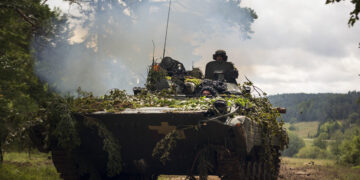
By Geoff LaMear
October 11, 2025
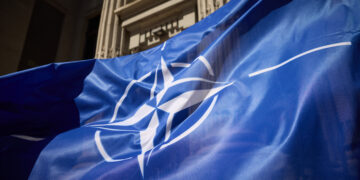
September 30, 2025
Featuring Daniel Davis
September 25, 2025
Events on NATO
